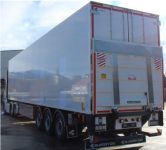
Fosen Transport uses RFID trailers
[ad_1]
Norwegian truck and semi-trailer body engineering company Bussbygg, along with transportation company Fosen and RFID provider HRAFN, have jointly developed and piloted an RFID-based refrigerated trailer and cloud software system to track the location of palletized products within the truck’s cargo area and ensure pallet delivery to the right customer.
Bussbygg sells 250 custom fiberglass refrigerated trailers annually. The company says its trailers cost less than traditional metal trailers and are better at refrigerating items. In addition, fiberglass trailers have another advantage: more compatibility with RFID technology. Metal trailers can affect the transmission of UHF RFID readers, which also makes RFID use difficult. In addition, when the RFID antenna is installed in the metal trailer, the antenna needs to be attached to the inner wall, which also easily causes the antenna to be knocked loose or damaged.

Toril Hovdenak, CEO of Bussbygg, said: “We are delighted that HRAFN has reached out to us.RFIDIt’s always been part of our plan, but we don’t know how to use this technology. “
HRAFN company CTOGeir Vevle said: “Bussbygg and HRAFN worked together to install an RFID reader antenna array directly on the fiberglass layer of the trailer wall so that the antenna could not be seen. The only change Bussbygg needed was to place the trailer The interior aluminum reinforcements were changed to fiberglass. HRAFN also installed reflectors behind the antennas to keep the RF rays inside the trailer.”
Fosen Transport, one of Bussbygg’s largest customers, purchased two RFID trailers and tried them out to confirm what data could be collected during transport.
The system uses an R4300P ion UHF RFID reader with built-in GPRS modem provided by CAEN RFID, a GPS device that can be inserted into the reader’s USB port. The reader is mounted on the front of the container near the refrigeration unit. In addition, more than 10 antennas are built into the walls and floors on each side. The reader operates each antenna in turn via an antenna multiplexer provided by Keonn and transmits the read data via GPRS to the Cloud Electronic Product Code Information Service (EPCIS) software provided by HRAFN.

Fosen Transport drivers transport cargo between Oslo and Bode. Kathrin Fründt, project manager at Fosen, said that due to the distance between the distribution center and the retail store, there were some unpredictable challenges and human errors along the way. When delivery is delayed, there is a chance that the product inside the truck will be damaged. Sometimes the driver will deliver the pallet to the wrong place.
In 2010, Fosen started looking for an automated solution to get real-time information on product locations and delivery times. At the time, the company installed an RFID antenna inside a semi-trailer. “We screwed the antenna into the interior of the trailer, which is a very simple solution,” says Fründt. The feedback from Fosen employees and customers on the test was very positive, which also convinced the company to look for a permanent solution for the built-in antenna.
Last spring, Byssbygg began a pilot on two trailers. The two mainly transport goods between the distribution center in Oslo and the Coop retail store in Røros.
The pilot project trialled reusable trays with built-in UHF RFID tags provided by NLP. Most suppliers and retail stores in Norway are starting to use the pallets, although only a few of them have RFID capabilities, Vevle said. A PDF100 antenna array provided by HRAFN is installed in the trailer. When the cargo is loaded on the trailer, the antenna will read the pallet tag ID and upload the tag data and GPS location to the HRAFN EPCIS software.
The software will store the pallet’s unique RFID number, cargo information, and data on when and where it was delivered.
When the pallet is removed from the trailer, the reader will no longer detect the tag ID and the software will determine that the pallet has been delivered to the customer. The software will then update the GPS data with the latest status.
“We share this data openly with our customers,” Fründt said. “Our goal is to reduce delivery times and improve quality and customer service throughout the supply chain.”
The system not only provides Fosen managers with real-time truck location data, cargo data, but also helps reduce errors. HRAFN can provide pallet position data, so when a pallet is sent to the wrong location, the administrator can know this data before the driver leaves. Likewise, if the driver does not deliver all the pallets that need to be delivered at the delivery location, the software will also detect the problem and send an alert to the driver and manager.
In addition, the program will send a notification to retail stores when a delivery trailer arrives within 30 minutes of the delivery location. At the same time, in the event of disputes, the technology can also provide evidence of loading and unloading. As a result, the driver no longer has to provide paper records to the retail store recipient, and the retail store does not need to compare goods and listings. So far, Bussbygg has seen a 30-minute reduction in delivery time.
In the next step, the company will attach RFID tags to ordinary wooden pallets for testing, Fründt said. Fründt explained: “We hope to complete this test this autumn and winter. In the next step, Fosen will offer its customers the RFID business.”
Bussbygg will provide RFID trailers for the transport company, Hovdenak said. She added: “Large companies will benefit more from RFID technology.”
(The exclusive manuscript of rfid world network, please indicate the source author for reprinting!)
[ad_2]



